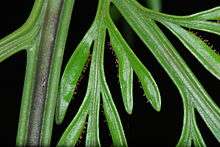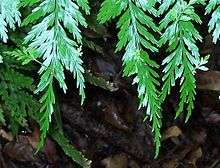Asplenium bulbiferum
| Asplenium bulbiferum | |
|---|---|
 | |
| Scientific classification | |
| Kingdom: | Plantae |
| Division: | Pteridophyta |
| Class: | Polypodiopsida/Pteridopsida (disputed) |
| Order: | Polypodiales |
| Family: | Aspleniaceae |
| Genus: | Asplenium |
| Species: | A. bulbiferum |
| Binomial name | |
| Asplenium bulbiferum G.Forst. | |
Asplenium bulbiferum, known as mother spleenwort, is a fern species native to New Zealand only. It is also called hen and chicken fern and, in the Māori language, pikopiko, mouku or mauku. Its fronds are eaten as a vegetable. It is often confused with A. gracillimum which is a fern species native to both New Zealand and Australia. Earlier literature refers to the Australian plants as Asplenium bulbiferum s.sp. gracillimum.
Hen and chicken ferns grow small bulbils on top of their fronds. Once grown to about 5 cm (2 in), these offspring fall off and, provided the soil they land in is kept moist, develop a root system and grow into new ferns. This additional means of reproduction can be employed with greater ease than propagation by spores. The related species A. viviparum has a similar mode of reproduction.
The hen and chicken fern commonly grows in most bush areas in New Zealand and is also commercially grown and sold. It thrives in many situations from shade to partial sunlight, and is also suitable and popular as an indoor plant, including areas with low light.

References
- Nutritional value of NZ edible plants: Pikopiko
- Indigenous Maori food ingredients: Pikopiko
- New Zealand Plant Conservation Network: Asplenium bulbiferum
| Wikimedia Commons has media related to Asplenium bulbiferum. |
| Wikispecies has information related to: Asplenium bulbiferum |